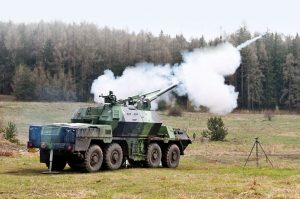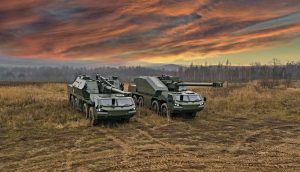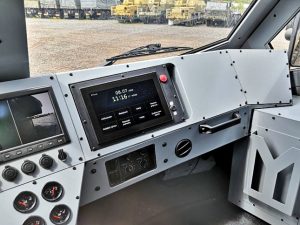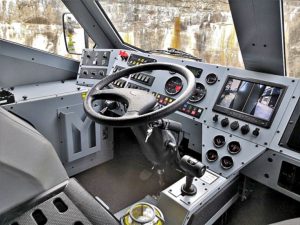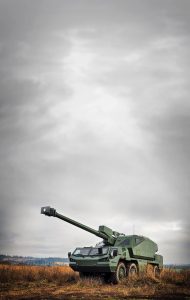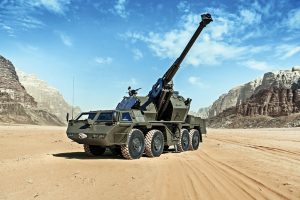
A technology named after a girl or a women makes for an interesting insight.
Story by Milan Olšanský
ClAt the recent international military technology fair IDEX 2021 in Abu Dhabi (SAE), a state-of-the-art self-propelled canon howitzer made news because of its technological prowess. It also made news because of its name DITA, which would ideally represent a girl or a women. Presented by Czech companies CSG and Tatra, the self-propelled canon howitzer, as a technological demonstrator, is based on the proven Tatra 815 model series chassis, which is more than four decade old! A combat superstructure of an automatically charged 155 mm caliber howitzer is located on the chassis. It is situated such that the autonomous superstructure functions as part of an automatic charging system and an ultra-modern fire control system. The three make main trumps of a combat vehicle on a wheeled chassis with an interesting and relatively long history within several European, Asian and African armies. The ShkH 155 mm DITA is a direct descendant of the original combat system ShkH Dana 152 mm vz. 77, which came into service in the then Czechoslovak People’s Army in 1977. That, again was over forty years ago.
Unique solution
It made for a unique solution then. The one that made for a self-propelled cannon howitzer on a wheeled chassis. Aligning well with the then military doctrine of the Soviet Union and its satellites within the framework of the Warsaw Pact to strike tank alliances with the support of highly mobile heavy artillery, it, as ShKH Dana with a means to direct fire on the line of contact up to 20 km beack from own front called for high mobility and unlike in USSR where due to the geographical conditions, it was common to work with crawler vehicles. The need for really high mobility called for in ordinary buildings areas and on the common road infrastructure of Western European countries, especially the then West Germany, meant that a wheeled chassis would do well. Also the reason why the then command of the Czechoslovak Army (Czechoslovak People’s Army) decided to go for a wheeled chassis. Another strong reason was the existence of the truck manufacturer Tatra.
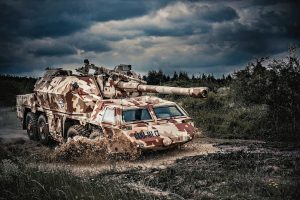
Within the trade and economic association of Eastern European CMEA countries (Tatra was considered a universal manufacturer of heavy trucks for all members of the CMEA), Tatra enjoyed a strong reputation. Above all, it was in the process of unveiling a completely new range of T 815 heavy trucks, which were developed and tested for ten years! They were developed by taking into account their possible involvement in special military projects. Therefore the type designation T 815 (eight at the beginning of the numerical code was earmarked for military vehicles). The four-axle T 815 chassis (even before the mass production of T 815 began) was chosen as the perfect platform for future armored self-propelled howitzers. The air-cooled supercharged twelve-cylinder engine of the then brand new T3 family, with an output of 275 kW (369 hp) was found to be sufficient and suitable. The only thing that had to be done was to completely change the orientation of the chassis because of the character and uncompromising functionality of the entire weapon system. The chassis was turned ‘facing backwards’ one hundred and eighty degrees to ensure ideal engine fitment.
The best in its category
All made in Czechoslovakia at that time, and considered to the best in the category as well as top of the tech ladder was the weapon superstructure with a 152 mm cannon, automatic system for charging divided ammunition (grenade and cartridge), layered armor of the cabin and gun turrets preventing both the passage of 7.62 mm projectiles up close and some effects of mass, biological and nuclear weapons, sights for direct and indirect fire and a great brake reversing device. ShkH Dana served mainly in the armies of Czechoslovakia (407 pieces), the Soviet Union (108 pieces), Poland (111 pieces), Libya (5 pieces) and Georgia (47 pieces). After the economic and social coup of 1989 in Czechoslovakia and the subsequent collapse of the USSR in 1991, the Dana model 77 system was forgotten for a while.
New brothers, new fraternity
Czechoslovakia, respectively after 1993, only the Czech Republic and the Slovak Republic, as independent countries, received new friends, allies and brothers. A different idea emerged, as well as a different military doctrine related to the exchange of parties. Becoming members of the NATO military offensive pact even before the end of the millennium, they came to have a completely different military doctrine. Tanks and heavy artillery were thought to have survived. Gradually, the so-called Cold War ended and the interest of military hawks turned to smart and sophisticated weapons. The so-called Arab Spring came and was followed by the biggest local conflict in Syria. An interesting finding based on the analysis of combat operations in such clashes concerning tanks and heavy artillary made it obvious that the self-propelled guns had not yet lost their utility value.
This prompted the industries of all countries to begin to turn to their World War II roots and look for the right incarnation in the segment of such weapons for the 21st century. Already at the time of the greatest glory of Dana’s combat systems, there were considerations and even prototypes of possible followers. Thus, for example, the Ondava system came in, which differed only in small details. Later, especially in Slovakia, they came up with the modernization of the Dana system in the form of the redesigned ShkH Zuzana (1992 – 1995) and Zuzana 2 (1996 – 2004). These reflected a near complete reconstruction and especially a new caliber standard (155 mm); the caliber NATO standard. Ironically, the ShkH Zuzana though still prefers to partner with the Tatra 815 chassis, albeit with Tatra T3 eight-cylinder forks to be precise.
Modernisation and innovation
Not to be left behind, in 2011, in the Czech Republic either, the first modernisation of the Dana system was marked by the Dana M1 CZ 152 mm with a new modern cabin. Questions were asked, Why modernisation and why use the 152 mm caliber yet? The answer given was a tad complex but was highly effective. It pointed at the continuing use of the system by several armies in Europe. It also underlined the fact that the Dana system is a real and unadulterated weapon system with excellent mobile, shooting and tactical results. The Czech Army, the Slovak Army, the Polish Army and the Russian Army too uses it. The 152 mm caliber, on the top of it all, is supported by an economic argument. With the care of a good manager, it must be stated that there are still 152 mm caliber ammunition in the stored reserves of the Czech Army for about four-billion crowns (about 18 million USD). They should be used or sold. The company Excalibur Army, however, been long involved in the modernisation of the Dana system, came to be convinced of the fact that it would be difficult to fight windmills in addition to military mills.
In 2017, another round of modernisation of the Dana M1M was announced. It brought it the most modern fire control system from the Retia company belonging to the Czechoslovak Group, which also includes the original Excalibur Army. The Army of the Czech Republic hesitated and issued conflicting opinions on the need to modernize the Dana system, but also on the purchase of the French Nexter Caesar 155 mm system, this time also built on a standard Tatra chassis – a highly modern unit from Tatra Force to boast of. The Tatra chassis helped the presentation of a modern Dana M1M system to appear in the armament of the army of Azerbaijan. The fact that Kypr is providing 12 pieces of ShkH Zuzana, made for a compelling case. In 2020, Ukraine also ordered 60 new Dana M2 systems. It eventually reduced the order to 22 pieces.
 Dana M2 vs. NEXTER CAESAR
Dana M2 vs. NEXTER CAESAR
In June 2018, CSG presented the third round of modernisation of the Dana system with the M2 designation and a new cabin. Changes to the age-old chassis and a new ballistic computer were carried out. The howitzer still had a caliber of 152 mm and its opponents still argued for a ‘small’ range! This, when using ammunition DN1CZ was very solid. The range was almost 30 km. The pressure from staunch members of the NATO Pact, that ‘you do not have a 155 mm standard calibre’ brought to the fore the ShkH Nexter Caesar 155 mm system once again. Leaving aside that 152/155 caliber duel, the literally abysmal difference being in the use of the weapon system, the Nexter Ceaser 155 mm system seemed to gain attention. While Dana in the original solution and in all its modernization steps represents a completely unique highly mobile compact combat device with a high degree of protection of the operator’s crew even on the touch line, the Nexter Caesar, at the end of the day, is only a carrier of the cannon howitzer!
Effective firing can only be conducted from an armored or from a highly fortified firing position. This, provided the operating crew, including the driver and commander of the vehicle, is outside the vehicle. The weapon system, in addition, has only a semi-automatic charging system. That is, each grenade (weighing approximately 50 kg), each cartridge (weighng approximately 14 kg) must be taken by the cannon operator and placed manually in the charging basket! The crew, in such a situation, undoubtedly, is well exposed to the effects of enemy fire. With the Caesar system, there could be no question of direct shooting in the event of a sudden necessity. Its ability is limited. It is not that good at firing at angles. Especially, considering the placement of the barrel of the howitzer above the carrier’s cabin. Another is the inability to shoot with negative angles of elevation. It must therefore be stated that Dana and Caesar are completely different weapons corresponding to a completely different tactical deployment.
 CSG does not give up
CSG does not give up
Refusing to cede its modernisation activities, CSG, by virtue of having in its kitty the best weapons system ever in Czechoslovakia, conducted another round of modernisation (read significant modernisation) in 2021. It presented the DITA ShkH 155 mm system, the most significant change in it being the use of the 155 mm caliber of the NATO standard. The entire system is controlled only by the driver and the commander of the car from the workplace of the chassis cab. This means that a two-tower superstructure with a firing diameter of 40 rounds of divided ammunition can work in a fully autonomous mode. There is only an emergency workplace. When using ammunition with a so-called gas generator, the range of the DITA system is 155 mm of the desired almost 39 km. The drive is a forked air-cooled eight-cylinder Tatra T3-928-90, which thanks to the development, can provide a full 300 kW power. The number would certainly evoke a discussion whether it would not be better to have a 400 kW engine for a 29-tonne heavy vehicle.
On the back of the fact that the entire vehicle is scalable in terms of further and future development, there’s another angle to it too. It concerns the air-cooled twelve-cylinder Tatra, which was in the original Dana system. It had a ‘dream’ output of 400 kW and looks set to return to the scene. A part of the modernisation is the use of original Tatra transmission in the DITA system. It is supplemented by an electronic Tatra Norgren gearshift system. The truth, however, is that one has to learn to live with this system. It is not fot those who get impatient soon. Interestingly, the manufacturer talks about two chassis options – the first being found on the technological demonstrator at Abu Dhabi in the form of the age-old highly mechanical T 815 chassis, albeit with excellent driving characteristics. It is considered as a real iron for combat. A hammer or an ax would not disappoint, as it has little reason to disappoint. The second option is a modern Tatra chassis from the Force series of vehicles. It is replete with a pneumatic suspension system built by Nexter Caesar.
The CSG states that this one has the ability to wade up to 1200 mm of water column. Similarly, it can cross 2000 mm, overcome a vertical (470 mm high) obstacle, climb 30 degrees and manage a static lateral tilt of 15 degrees. The modern Tatra chassis with the howitzer on it has 20-inch dia. wheels and R20 14.00 tyres. The DITA with a total length of 13.02 m and a total weight of 29-tonnes should be able to drive on paved roads at speeds of up to 90 kmph. It should drive ‘in the terrain’ at a speed of up to 15 kmph. My own verification – many times – has shown that the ShkH Dana vz 77 152 mm can reach a speed of 120 kmph at 11 m total length and 30 tonnes of total weight on a paved road. This verification is however is from thirty years ago; the time I served with this great weapon!
……………………………………………………..
CV is an associate member of the International Truck of the Year (IToY). As part of this association, the magazine provides exclusive articles, written especially by IToY jury members.



